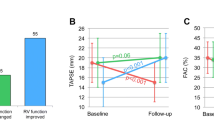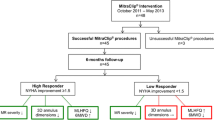Abstract
Cardiac resynchronization therapy (CRT) improves functional mitral regurgitation (MR); however, the mechanism and differences in acute and late improvement in MR are unclear. We aimed to evaluate the factors associated with the acute and late MR improvements and the prognosis of MR improvement after CRT. This retrospective study included 121 patients who underwent CRT implantation with full echocardiography assessment at baseline, 1 week, and 6 months after implantation. MR severity was classified into five grades (0: none to 4: severe). Two-dimensional speckle-tracking echocardiography with radial strain was used to assess dyssynchrony, and the time difference between the lateral and inferior segments at papillary muscle levels (TDlate-inf) was calculated. The MR improved 1 week and 6 months after CRT in 40 (33%) and 45 (37%) patients, respectively. On multivariate analyses, TDlate-inf (baseline–1 week) and SPWMD were independently associated with acute MR improvement. The %reduction in left ventricular end-systolic volume (LVESV) (baseline–6 months) and TDlate-inf (baseline–1 week) were independently correlated with late MR improvement. The patients with pre-MR grades 2–4 and improved MR after CRT showed significantly better prognosis in heart failure hospitalization. Cutoff values of ≥ 19.5 ms of the reduction of TDlate-inf and ≥ 30.8% of the %reduction of LVESV were significantly associated with the decrease in heart failure hospitalization. The improved interpapillary muscle activation time delay and volume reduction after CRT were associated with acute and late MR improvements. There may be different time course of recovery and distinct causes for late MR improvement.




Similar content being viewed by others
References
Nasser R, Van Assche L, Vorlat A, Vermeulen T, Van Craenenbroeck E, Conraads V, Van der Meiren V, Shivalkar B, Van Herck P, Claeys MJ (2017) Evolution of functional mitral regurgitation and prognosis in medically managed heart failure patients with reduced ejection fraction. JACC Heart Fail 5:652–659
Agricola E, Stella S, Figini F, Piraino D, Oppizzi M, D’Amato R, Slavich M, Ancona MB, Margonato A (2011) Non-ischemic dilated cardiopathy: prognostic value of functional mitral regurgitation. Int J Cardiol 146:426–428
Rossi A, Dini FL, Faggiano P, Agricola E, Cicoira M, Frattini S, Simioniuc A, Gullace M, Ghio S, Enriquez-Sarano M, Temporelli PL (2011) Independent prognostic value of functional mitral regurgitation in patients with heart failure. A quantitative analysis of 1256 patients with ischaemic and non-ischaemic dilated cardiomyopathy. Heart 97:1675–1680
Kajimoto K, Sato N, Takano T, Investigators of the Acute Decompensated Heart Failure Syndromes (ATTEND) Registry (2016) Functional mitral regurgitation at discharge and outcomes in patients hospitalized for acute decompensated heart failure with a preserved or reduced ejection fraction. Eur J Heart Fail 18:1051–1059
Smith PK, Puskas JD, Ascheim DD, Voisine P, Gelijns AC, Moskowitz AJ, Hung JW, Parides MK, Ailawadi G, Perrault LP, Acker MA, Argenziano M, Thourani V, Gammie JS, Miller MA, Page P, Overbey JR, Bagiella E, Dagenais F, Blackstone EH, Kron IL, Goldstein DJ, Rose EA, Moquete EG, Jeffries N, Gardner TJ, O’Gara PT, Alexander JH, Michler RE, Cardiothoracic Surgical Trials Network I (2014) Surgical treatment of moderate ischemic mitral regurgitation. N Engl J Med 371:2178–2188
Michler RE, Smith PK, Parides MK, Ailawadi G, Thourani V, Moskowitz AJ, Acker MA, Hung JW, Chang HL, Perrault LP, Gillinov AM, Argenziano M, Bagiella E, Overbey JR, Moquete EG, Gupta LN, Miller MA, Taddei-Peters WC, Jeffries N, Weisel RD, Rose EA, Gammie JS, DeRose JJ Jr, Puskas JD, Dagenais F, Burks SG, El-Hamamsy I, Milano CA, Atluri P, Voisine P, O’Gara PT, Gelijns AC, Ctsn (2016) Two-year outcomes of surgical treatment of moderate ischemic mitral regurgitation. N Engl J Med 374:1932–1941
Obadia JF, Messika-Zeitoun D, Leurent G, Iung B, Bonnet G, Piriou N, Lefevre T, Piot C, Rouleau F, Carrie D, Nejjari M, Ohlmann P, Leclercq F, Saint Etienne C, Teiger E, Leroux L, Karam N, Michel N, Gilard M, Donal E, Trochu JN, Cormier B, Armoiry X, Boutitie F, Maucort-Boulch D, Barnel C, Samson G, Guerin P, Vahanian A, Mewton N, InvestigatorsM-F (2018) Percutaneous repair or medical treatment for secondary mitral regurgitation. N Engl J Med 379:2297–2306
Stone GW, Lindenfeld J, Abraham WT, Kar S, Lim DS, Mishell JM, Whisenant B, Grayburn PA, Rinaldi M, Kapadia SR, Rajagopal V, Sarembock IJ, Brieke A, Marx SO, Cohen DJ, Weissman NJ, Mack MJ, Investigators C (2018) Transcatheter mitral-valve repair in patients with heart failure. N Engl J Med 379:2307–2318
Grayburn PA, Sannino A, Packer M (2019) Proportionate and disproportionate functional mitral regurgitation: a new conceptual framework that reconciles the results of the MITRA-FR and COAPT Trials. JACC Cardiovasc Imaging 12:353–362
Ypenburg C, Lancellotti P, Tops LF, Boersma E, Bleeker GB, Holman ER, Thomas JD, Schalij MJ, Pierard LA, Bax JJ (2008) Mechanism of improvement in mitral regurgitation after cardiac resynchronization therapy. Eur Heart J 29:757–765
Onishi T, Onishi T, Marek JJ, Ahmed M, Haberman SC, Oyenuga O, Adelstein E, Schwartzman D, Saba S, Gorcsan J 3rd (2013) Mechanistic features associated with improvement in mitral regurgitation after cardiac resynchronization therapy and their relation to long-term patient outcome. Circ Heart Fail 6:685–693
Kanzaki H, Bazaz R, Schwartzman D, Dohi K, Sade LE, Gorcsan J 3rd (2004) A mechanism for immediate reduction in mitral regurgitation after cardiac resynchronization therapy: insights from mechanical activation strain mapping. J Am Coll Cardiol 44:1619–1625
van der Bijl P, Khidir M, Ajmone Marsan N, Delgado V, Leon MB, Stone GW, Bax JJ (2019) Effect of functional mitral regurgitation on outcome in patients receiving cardiac resynchronization therapy for heart failure. Am J Cardiol 123:75–83
Di Biase L, Auricchio A, Mohanty P, Bai R, Kautzner J, Pieragnoli P, Regoli F, Sorgente A, Spinucci G, Ricciardi G, Michelucci A, Perrotta L, Faletra F, Mlcochova H, Sedlacek K, Canby R, Sanchez JE, Horton R, Burkhardt JD, Moccetti T, Padeletti L, Natale A (2011) Impact of cardiac resynchronization therapy on the severity of mitral regurgitation. Europace 13:829–838
Cipriani M, Lunati M, Landolina M, Proclemer A, Boriani G, Ricci RP, Rordorf R, Matassini MV, Padeletti L, Iacopino S, Molon G, Perego GB, Gasparini M, Italian ClinicalService Project I (2016) Prognostic implications of mitral regurgitation in patients after cardiac resynchronization therapy. Eur J Heart Fail 18:1060–1068
JCS Joint Working Group (2013) Guidelines for non-pharmacotherapy of cardiac arrhythmias (JCS 2011). Circ J 77:249–274
Miyazaki C, Redfield MM, Powell BD, Lin GM, Herges RM, Hodge DO, Olson LJ, Hayes DL, Espinosa RE, Rea RF, Bruce CJ, Nelson SM, Miller FA, Oh JK (2010) Dyssynchrony indices to predict response to cardiac resynchronization therapy: a comprehensive prospective single-center study. Circ Heart Fail 3:565–573
Chung ES, Leon AR, Tavazzi L, Sun JP, Nihoyannopoulos P, Merlino J, Abraham WT, Ghio S, Leclercq C, Bax JJ, Yu CM, Gorcsan J 3rd, St John Sutton M, De Sutter J, Murillo J (2008) Results of the Predictors of Response to CRT (PROSPECT) trial. Circulation 117:2608–2616
Stankovic I, Prinz C, Ciarka A, Daraban AM, Kotrc M, Aarones M, Szulik M, Winter S, Belmans A, Neskovic AN, Kukulski T, Aakhus S, Willems R, Fehske W, Penicka M, Faber L, Voigt JU (2016) Relationship of visually assessed apical rocking and septal flash to response and long-term survival following cardiac resynchronization therapy (PREDICT-CRT). Eur Heart J Cardiovasc Imaging 17:262–269
Voigt JU, Schneider TM, Korder S, Szulik M, Gurel E, Daniel WG, Rademakers F, Flachskampf FA (2009) Apical transverse motion as surrogate parameter to determine regional left ventricular function inhomogeneities: a new, integrative approach to left ventricular asynchrony assessment. Eur Heart J 30:959–968
Parsai C, Bijnens B, Sutherland GR, Baltabaeva A, Claus P, Marciniak M, Paul V, Scheffer M, Donal E, Derumeaux G, Anderson L (2009) Toward understanding response to cardiac resynchronization therapy: left ventricular dyssynchrony is only one of multiple mechanisms. Eur Heart J 30:940–949
Inden Y, Ito R, Yoshida N, Kamiya H, Kitamura K, Kitamura T, Shimano M, Uchikawa T, Tsuji Y, Shibata R, Hirai M, Murohara T (2010) Combined assessment of left ventricular dyssynchrony and contractility by speckled tracking strain imaging: a novel index for predicting responders to cardiac resynchronization therapy. Heart Rhythm 7:655–661
Fujii A, Inden Y, Yanagisawa S, Mamiya K, Okamoto H, Sakamoto Y, Tomomatsu T, Shibata R, Murohara T (2019) Discontinuous contraction in the left ventricle assessed by 2-D speckle tracking echocardiography benefits from CRT. Pacing Clin Electrophysiol 42:1204–1212
Suffoletto MS, Dohi K, Cannesson M, Saba S, Gorcsan J 3rd (2006) Novel speckle-tracking radial strain from routine black-and-white echocardiographic images to quantify dyssynchrony and predict response to cardiac resynchronization therapy. Circulation 113:960–968
Lancellotti P, Moura L, Pierard LA, Agricola E, Popescu BA, Tribouilloy C, Hagendorff A, Monin JL, Badano L, Zamorano JL, European Association of E (2010) European Association of Echocardiography recommendations for the assessment of valvular regurgitation. Part 2: mitral and tricuspid regurgitation (native valve disease). Eur J Echocardiogr 11:307–332
Zoghbi WA, Enriquez-Sarano M, Foster E, Grayburn PA, Kraft CD, Levine RA, Nihoyannopoulos P, Otto CM, Quinones MA, Rakowski H, Stewart WJ, Waggoner A, Weissman NJ, American Society of E (2003) Recommendations for evaluation of the severity of native valvular regurgitation with two-dimensional and Doppler echocardiography. J Am Soc Echocardiogr 16:777–802
Zoghbi WA, Adams D, Bonow RO, Enriquez-Sarano M, Foster E, Grayburn PA, Hahn RT, Han Y, Hung J, Lang RM, Little SH, Shah DJ, Shernan S, Thavendiranathan P, Thomas JD, Weissman NJ (2017) Recommendations for noninvasive evaluation of native valvular regurgitation: a Report from the American Society of Echocardiography Developed in Collaboration with the Society for Cardiovascular Magnetic Resonance. J Am Soc Echocardiogr 30:303–371
Ypenburg C, Lancellotti P, Tops LF, Bleeker GB, Holman ER, Pierard LA, Schalij MJ, Bax JJ (2007) Acute effects of initiation and withdrawal of cardiac resynchronization therapy on papillary muscle dyssynchrony and mitral regurgitation. J Am Coll Cardiol 50:2071–2077
St John Sutton MG, Plappert T, Abraham WT, Smith AL, DeLurgio DB, Leon AR, Loh E, Kocovic DZ, Fisher WG, Ellestad M, Messenger J, Kruger K, Hilpisch KE, Hill MR, Multicenter InSync Randomized Clinical Evaluation Study G (2003) Effect of cardiac resynchronization therapy on left ventricular size and function in chronic heart failure. Circulation 107:1985–1990
Packer M, Grayburn PA (2019) Contrasting effects of pharmacological, procedural, and surgical interventions on proportionate and disproportionate functional mitral regurgitation in chronic heart failure. Circulation 140:779–789
Packer M, Grayburn PA (2020) New evidence supporting a novel conceptual framework for distinguishing proportionate and disproportionate functional mitral regurgitation. JAMA Cardiol 5:469–475
Verhaert D, Popovic ZB, De S, Puntawangkoon C, Wolski K, Wilkoff BL, Starling RC, Tang WH, Thomas JD, Griffin BP, Grimm RA (2012) Impact of mitral regurgitation on reverse remodeling and outcome in patients undergoing cardiac resynchronization therapy. Circ Cardiovasc Imaging 5:21–26
Upadhyay GA, Chatterjee NA, Kandala J, Friedman DJ, Park MY, Tabtabai SR, Hung J, Singh JP (2015) Assessing mitral regurgitation in the prediction of clinical outcome after cardiac resynchronization therapy. Heart Rhythm 12:1201–1208
Enriquez-Sarano M, Avierinos JF, Messika-Zeitoun D, Detaint D, Capps M, Nkomo V, Scott C, Schaff HV, Tajik AJ (2005) Quantitative determinants of the outcome of asymptomatic mitral regurgitation. N Engl J Med 352:875–883
Funding
This research did not receive any specific grant from funding agencies in the public, commercial, or not-for-profit sectors.
Author information
Authors and Affiliations
Corresponding author
Ethics declarations
Conflict of interest
The authors declare that they have no conflict of interest.
Ethical approval
This study was approved by the ethics committee of Nagoya University Hospital.
Informed consent
Informed consent was obtained before the procedure from all individual participants included in the study.
Additional information
Publisher's Note
Springer Nature remains neutral with regard to jurisdictional claims in published maps and institutional affiliations.
Rights and permissions
About this article
Cite this article
Okamoto, H., Inden, Y., Yanagisawa, S. et al. The mechanism and prognosis of acute and late improvement in mitral regurgitation after cardiac resynchronization therapy. Heart Vessels 36, 986–998 (2021). https://doi.org/10.1007/s00380-021-01771-9
Received:
Accepted:
Published:
Issue Date:
DOI: https://doi.org/10.1007/s00380-021-01771-9




